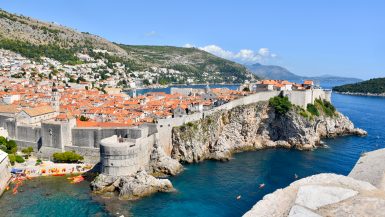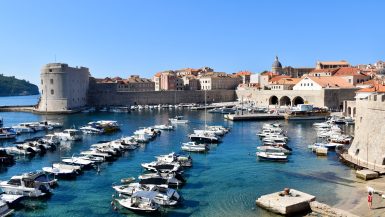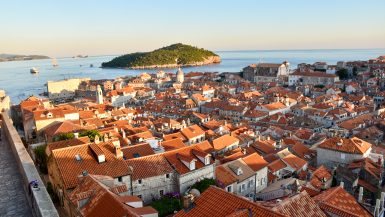There’s nothing better than exploring a new place on foot, stopping if something catches your eye, or wandering off the beaten track if it looks appealing. Taking a Seville walking tour, either with a group or self-guided, is the perfect way to get to know this beautiful city. For those who want to explore under their own steam, here’s a good introductory route for your first day in the city (with approximate timings), deliberately bypassing the wonderful Cathedral and Royal Palace to explore in detail on another day.
Self-guided Seville Walking Tour
Start at Hotel Alfonso XIII (10.00 am)
The Alfonso XIII is a luxury hotel right in the middle of Seville, built by King Alfonso XIII for the VIP guests to the 1929 Exposition. It’s a good starting point for a tour as there’s a tram stop immediately outside the hotel gates, and a metro station opposite (Puerta Jerez station).
Even if you do not stay here, it is a landmark in Seville and gathers many admirers outside due to its beautiful exterior framed by palm trees. Inside, the hotel retains many of its original features including wonderful old wooden lifts and azulejos (tiles) from the neighbourhood of Triana.
Horse and carriages wait outside the hotel if you fancy riding through the city’s parks in style. But today, you are on a Seville walking tour and so the horses will have to wait!

Carmen’s Tobacco Factory (10.15am)
From Hotel Alfonso XIII, walk towards the northern entrances to the Santa Luisa Park, and on the way admire the enormous building now owned by the University of Seville. This building, constructed between 1728 and 1771, used to be a Tobacco Factory providing work for 12,000 (predominantly female) employees. These “Cigarette girls” were apparently the inspiration for Carmen, the tragic heroine of Bizet’s opera written in 1875. Carmen was famously known for the fact that she could roll the cigars between her thighs!
Unfortunately, today, all you can do is admire the building from the outside and then continue your journey to Santa Luisa Park.

Santa Luisa Park (10.30am)
Enter Santa Luisa Park from the north, taking Av. Isabel la Católica off the roundabout and through this beautiful park which was donated to the public in 1893. Enjoy strolling along this tree-lined boulevard towards the impressive Plaza de España.

Plaza de España (Spanish Square) (10.45 – 11.30am)
Plaza de España was built in 1928 for the Ibero-American Exposition the following year which aimed to make ‘symbolic peace’ with Spain’s former American colonies. The Plaza was designed by Anibal Gonzàlez in a Spanish Renaissance style and comprises of a large semi-circular plaza with a central lake, on which you can rent a rowing boat (although they don’t go very far!), large fountain and pedestrian bridges.


The Plaza has a beautiful colonnade which is decorated with gorgeous, tiles (azulejos from Triana) including 52 tiled mosaics and benches for each of the provinces of Spain. You can walk up to the first-floor balconies of the colonnade for a better view over the Plaza.


This is a very popular spot with tourists so try to visit early in the day on your Seville walking tour before it fills up with people. We witnessed a couple having wedding photos taken on the steps of the colonnade and enjoyed the sound of buskers’ Spanish guitars in the background as we explored the area.


From Plaza de España, take a circular route through Santa Luisa Park and then retrace your steps back to the Alfonzo XIII Hotel.
From the Alfonso XIII, turn left down Av. Paseo de Cristina to reach the Torro del Oro.
Torre del Oro (Tower of Gold) (12.00noon – 12.30pm)
The Torre del Oro is a beautiful 12-sided Moorish style watchtower from the 13th century, which once formed part of the defence walls of the city. At the time it was built, there was a second tower on the other side of the Guadalquivir River – chains were strung between the two towers to stop unwanted ships passing through on the Guadalquivir River.
The river is 675 km long and was once trade route for exporting grains, wool, leather, cheese and metals to the Mediterranean Sea and Atlantic Ocean. When ships arrived from visits to Latin American colonies, they would unload their cargoes of gold here, hence the name of the tower.
Today there is a small museum in the ‘golden tower’ with photos,information boards and exhibits, and a lovely view over the river.
Lunch with a view at El Balcon de Rio Grande (12.30pm – 2.00pm)
If you cross over the Guadalquivir River, you will reach a terrace on the other side, home to the restaurant El Balcon de Rio Grande, where you can sit and enjoy lunch with river views across to the Torre del Oro. The restaurant offers small plates (restaurant plates as opposed to bar tapas) and restaurant dishes. Whilst it wasn’t our favourite food of the trip, we enjoyed the location and views.



Plaza de Toros – Bullring Real Maestranza (2.30pm – 3.30pm)
Walk off your lunch by crossing back over the bridge to the Torre del Oro and then strolling north for 10 minutes up the river promenade to the Plaza de Toros – Bullring Real Maestranza, the largest bullfighting in Spain built between 1762-1881. Spot the statue of Carmen outside the bullring (on the river side of the road) which was mentioned in the original story which became a famous opera by Bizet.



Note – I am not a fan of bullfighting from the perspective of animal welfare but understand that it’s important part of the Spanish culture. So, whilst I wouldn’t have the stomach to watch a bullfight myself, I am still interested to learn about this as a Spanish traditional.
You can book a guided tour of the site, but we just explored the Museum of Bullfighting and Matador exhibits ourselves – the Matador outfits on display were colourful, elaborate and tiny!

There’s a small church on site where the matadors can pray before fighting the bulls, and several key gates through which the matadors enter and leave the arena – only certain gates can be used at certain times, such as it you are being celebrated (Prince’s Gate).
Step into the huge arena which hosts the largest bullfighting festival in the world during the Feria de Abril. The arena can hold up to 13,000 people and is painted in beautiful red and Seville yellow colours. It is used for regular bullfights on Sunday evenings between Easter and October.


Go looking for mushrooms (‘the Setas’) (4.00-5.00pm)
Next on your Seville walking tour it’s time to go looking for mushrooms! Take a 17-minute walk from the bullring, through the narrow streets of Seville to The Setas at Metropol Parasol.
This is the largest wooden structure in the world comprised of 6 toadstool-shaped wooden pavilions designed by German architect Jurgen Mayer in 2005. It looks like a massive wooden Meccano kit and is one of the most instagrammable spots in Seville!
When the car park was dug up to build the Setas, Roman ruins were found underneath and so today there’s a small archaeological museum on the ground floor of the Metropol Parasol, along with a tourist office, indoor market, bars, and restaurants.
If you pay to go up to the top of the mushrooms, you will be rewarded with super views over the rooftops of Seville from a series of walkways weaving around the mushroom tops with 360-degree views.
There’s also a small cinema sensory experience included as part of the visit, where you can watch a short film about Seville whilst hot or cold air and the scent of orange blossom is blown into the room to match the narration.




Pre-dinner drinks at the Casa de Indias (5.00-6.30pm)
Next to the Setas, locate the Casa de Indias Hotel and head upstairs to its rooftop bar which overlooks the mushrooms. It’s a lovely spot for a pre-dinner drink and to watch the sun set.
Note – if you visit the Setas at night, they are illuminated in different colours which look great!


Optional walk to the Alameda de Hércules (6.30pm – 7.30pm)
We had booked dinner at El Rinconcillo which is only a 5-minute walk from the Setas, but if it’s too early to eat, you can take this optional walk.
From the Setas, walk north towards the Macarena area for a very different feel. The area is full of low-key ceramics shops, vintage clothing, local provisions shops and eateries.
We popped into a couple of churches along the way to have a look the incredible decorations beyond the plain exteriors, and then doubled back along the Alameda de Hércules.
The Alameda de Hércules is a large tree-lined promenade with parents enjoying drinks in outdoor cafes whilst their kids played nearby. Hércules features with Julius Caesar on two Roman columns at the southern end of the promenade. Stop for a drink and soak up the atmosphere until you’re ready to head for dinner.
Enjoy dinner at El Rinconcillo (8.00pm)
For the final stop on your Seville walking tour, from the Alameda de Hércules wander towards El Rinconcillo in the Santa Cruz area of Seville. El Rinconcillo is the oldest bar in the city, which has been operating since 1670 and serves fantastic tapas.
Note – if you want to be certain of getting in, as it is very popular, then try to book a table rather than hedging your bets in the bar area.
We had booked a table for opening time at 8.00pm and arrived around 7.45pm to find quite a crowd of people waiting in pole position by the doors for opening time. We were relieved to have booked and the experience did not disappoint – white tablecloths, jamon hanging over the bar, very helpful waiter, great menu, delicious food and lively atmosphere.
If you don’t get a seat at one of the tables and just had tapas at the bar then you might want to continue on a tapas trail around Seville.
The perfect way to end your Seville walking tour!
Thank you so much for reading my blog, I hope you found it useful?
For more stories, itineraries, and advice, check out my Related Posts and sign up to receive my blogs by email.
If you have a blog-related question, please do ask in the Comments box and I’ll try to help…
Request please – if you use my photos, then please credit Love Travel Planning on your social media or give me a shout out on Instagram @lovetravelplanning as I am growing my website. Huge thanks.
Enjoy your travels!





Leave a reply
You must be logged in to post a comment.